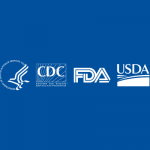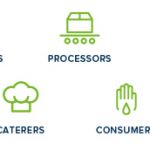Food is essential for human life, but ironically, it can also be a source of harm. Unsafe food, contaminated with pathogens or chemical hazards, is estimated to cause millions of illnesses and thousands of deaths globally each year. According to the World Health Organization (WHO), 1 in 10 people get sick because of contaminated food and 420,000 people die due to foodborne illnesses every year around the world (WHO, Food Safety, 2022). However, the impact of unsafe food extends far beyond individual health, creating a significant financial burden on individuals, healthcare systems, and national economies.
Food safety is a critical issue that impacts both public health and the economy, especially in areas where there is not enough food, no clean water, open defecation, poor hygiene, lack of electricity and lack of cooling system, weak food safety education and loose regulatory systems. In addition to its impact on public health, food safety also affects economies, resulting in the cost of recalls, lost businesses, damaged reputations, lost lives, and lost working hours. Here, we explore the challenges that countries face in ensuring safe food and its economic impacts and the potential solutions to these challenges.
Financial Impact of Unsafe Food
The financial cost of unsafe food encompasses various direct and indirect expenses. These costs arise from both the immediate impacts of foodborne illnesses and the long-term consequences on public health, productivity, and economic well-being. Here are some key components of the financial cost of unsafe food:
Healthcare Costs:
-
- Treatment Expenses: Individuals affected by foodborne illnesses often require medical attention, leading to costs associated with hospitalization, medication, doctor visits, and diagnostic tests.
- Emergency Response: Public health agencies and emergency services may incur significant expenses in responding to outbreaks, conducting investigations, and implementing control measures.
Product Recalls and Market Loss:
-
- Recall Costs: When contaminated or unsafe food products are identified, manufacturers may have to recall the products from the market. The costs associated with the retrieval, disposal, and destruction of the affected products can be substantial.
- Market Loss: Companies may suffer financial losses due to the damage to their reputation and the decline in consumer trust, leading to reduced sales and market share.
Workforce Productivity Loss:
-
- Absenteeism: Foodborne illnesses can lead to increased absenteeism in the workforce as employees may need time off to recover or seek medical treatment.
- Reduced Productivity: Even employees who are present at work may experience reduced productivity due to illness-related fatigue and discomfort.
Government and Regulatory Costs:
-
- Inspection and Enforcement: Governments invest resources in inspecting food production facilities, enforcing regulations, and monitoring compliance with food safety standards.
- Legal Proceedings: Legal actions, such as lawsuits against companies responsible for unsafe food, can result in additional costs for both businesses and the legal system.
Insurance Costs:
-
- Liability Insurance: Businesses in the food industry may face increased premiums for liability insurance to cover potential legal claims resulting from foodborne illnesses.
- Product Recall Insurance: Companies may also invest in product recall insurance to mitigate the financial impact of recalling unsafe products.
Loss of Trade and Tourism:
-
- International Trade: Countries exporting food products may face trade restrictions and bans if their products are associated with safety concerns, resulting in economic losses.
- Tourism: Foodborne illness outbreaks can negatively impact the tourism industry if destinations are perceived as unsafe.
Long-term Health Costs:
-
- Chronic Health Conditions: Some foodborne illnesses can lead to chronic health conditions, imposing ongoing healthcare costs and reducing individuals’ long-term productivity.

The most immediate financial impact of unsafe food is incurred through direct medical expenses associated with treating foodborne illnesses. These costs encompass doctor visits, hospital stays, medications, and laboratory tests. A 2018 World Bank study estimated that foodborne illnesses cost low- and middle-income countries around $110 billion annually in medical expenses alone. In the U.S., the Centers for Disease Control and Prevention (CDC) estimates the annual cost of foodborne illnesses at $78 billion, with hospitalizations accounting for a significant portion.
Recalls can result in significant financial losses for food producers and retailers. For example, in 2006, a spinach contaminated with E. coli recall cost the industry $350 million (Kudashkina, Corradini, Thirunathan, Yada, & Fraser, 2022). In developing countries, where food safety regulations may be weak or nonexistent, the cost of recalls can be even higher, as the risk of contamination and outbreaks is greater.
Indirect costs include lost business and damaged reputations. In 2017, a listeria outbreak in South Africa linked to processed meat products resulted in the closure of several food processing plants, leading to job losses and economic damage to the industry and the deaths of 216 people (Tchatchouang, et al., 2020). Similarly, in 2011, an E. coli outbreak linked to sprouts in Germany led to a significant decline in demand for sprouts across Europe, resulting in lost revenue for farmers and producers (Buchholz, Bernard, Werber, Böhmer, & Remschmidt, 2011).
Beyond direct medical expenses, unsafe food leads to significant indirect costs for the consumer through lost productivity. Individuals suffering from foodborne illnesses miss work or school, leading to lost wages and reduced economic output. Additionally, families may incur childcare costs or lost productivity due to caring for sick individuals. The CDC estimates that lost productivity due to foodborne illnesses costs the U.S. economy around $55 billion annually.
Disproportionate Burden on Vulnerable Populations
It is crucial to recognize that the financial burden of unsafe food is not evenly distributed. Low- and middle-income countries are disproportionately affected due to limited access to clean water, sanitation, and robust food safety regulations. Children, pregnant women, and the elderly are also more vulnerable to foodborne illnesses due to weaker immune systems. This unequal impact exacerbates existing inequalities and hinders economic development in vulnerable communities.
Challenges for Developing Countries
One of the most significant challenges in developing countries is the lack of access to clean water. According to WHO, in 2020 only 74% the global population had safe water (Bhagwat, 2019; WHO, Drinking Water, 2022), which is essential for maintaining proper hygiene and preventing the spread of foodborne illnesses (Marino, 2007). In many countries, access to clean water is limited and this accounts for around 282 million people, and around 368 million people may be forced to rely on contaminated or unprotected water sources, such as rivers or wells (WHO, Drinking Water, 2022). This can lead to the contamination of food products, as people may use contaminated water to irrigate crops, wash fruits and vegetables, or clean utensils.

Another challenge is the lack of access to electricity and cooling systems (Vipham, Chaves, & Trinetta, 2018), which makes it difficult to store and preserve food products. In many developing countries, electricity is not available in rural areas, and people may not have access to refrigeration or other cooling systems. This can lead to the spoilage of food products, which can cause foodborne illnesses (CDC, 2022) and result in economic losses for consumers, farmers and producers because food that requires refrigeration or freezing has to be thrown away after four hours if not kept at the recommended temperature (USDA, 2021).
Poor food safety education and regulatory systems are also significant challenges in various countries (Medeiros, Hillers, Kendall, & Mason, 2001). Many people in these countries may not be aware of the risks associated with consuming contaminated food or how to prevent foodborne illnesses. Additionally, regulatory systems may be weak or nonexistent, and food products may not be adequately monitored or tested for contaminants or pathogens. In addition, regulatory system costs cannot be prioritized over other pressing issues in many countries. The cost of food safety regulation can be between 4% and 20% per half kg of food (Ollinger & Moore, 2009).
In addition to the financial costs, food safety issues in developing countries can also result in lost lives and lost working hours. Based on WHO’s estimate globally there is $110 billion losses due in lost working hours and medical cost. Foodborne illnesses can cause severe illness and death, especially in vulnerable populations such as children and the elderly. Children carry 40% of the death burden from unsafe food (WHO, Food Safety, 2022).
Overcoming The Challenges
To address these challenges, a comprehensive integrated approach is needed that involves government, industry, and consumers. One potential solution is to improve access to clean water in rural areas. Governments can invest in water treatment facilities, establish regulations for the use of water sources in agriculture, and provide education and awareness campaigns on the importance of clean water for food safety.
Another potential solution is to promote the use of alternative cooling systems in areas where electricity is not available. This can include the use of solar-powered refrigerators or evaporative coolers, which can help to preserve food products and prevent spoilage. Governments and NGOs can also provide education and training on proper food storage and preservation techniques, such as canning or drying, to reduce food waste and improve food safety.

Another potential solution is to invest in food safety education and awareness campaigns. Governments, industry, and NGOs can work together to develop and implement educational programs on food safety such as proper handwashing, cooking, and storage techniques, and avoiding cross-contamination. These programs can be targeted at schools, community groups, and the general public to promote safe food practices and raise awareness of the risks associated with consuming contaminated food, and the importance of reporting illnesses to health authorities.
Another potential solution is to strengthen food safety regulations and monitoring systems in developing countries. Governments can establish and enforce regulations for food safety, including requirements for testing and monitoring of food products. They can also establish regulatory bodies responsible for overseeing the safety of the food supply, and provide training and resources to ensure that food producers and retailers comply with safety standards.
Finally, the promotion of sustainable agriculture practices can also contribute to food safety in developing countries. The use of chemical fertilizers and pesticides in agriculture can contaminate food products and harm human health. Governments can promote the use of sustainable agriculture practices, such as organic farming, which reduces the use of harmful chemicals and promotes the use of natural fertilizers and pest control methods.
This review provides a broad overview of the financial cost of unsafe food. Further research is needed to:
- Refine cost estimates to better understand the true economic burden of unsafe food in different regions and demographics.
- Evaluate the cost-effectiveness of different prevention and intervention strategies.
- Develop innovative financing mechanisms to support improved food safety measures in low- and middle-income countries.
- Investigate the link between unsafe food and malnutrition, considering the broader economic and social costs.
Unsafe food poses a significant and multifaceted financial burden on individuals, healthcare systems, and national economies. While the direct costs associated with medical treatment are substantial, the indirect costs of lost productivity and broader economic consequences create an even greater financial strain. By recognizing the disproportionate impact on vulnerable populations, continuing research and implementing proactive measures, we can build a safer, more sustainable, and economically sound food system for everyone.
References:
Bhagwat, V. (2019). Safety of Water Used in Food Production. doi:10.1016/B978-0-12-816333-7.00009-6
Buchholz, U., Bernard, H., Werber, D., Böhmer, M., & Remschmidt, C. (2011). German Outbreak of Escherichia coli O104:H4 Associated with Sprouts. New England Journal of Medicine, 365, 1763-1770.
CDC. (2022, October 27). Food Safety for Power Outages. Retrieved March 3, 2023, from https://www.cdc.gov/foodsafety/food-safety-during-a-power-outage.html#:~:text=Never%20taste%20food%20to%20determine,odor%2C%20color%2C%20or%20texture.
Kudashkina, K., Corradini, M., Thirunathan, P., Yada, R., & Fraser, E. (2022). Artificial Intelligence technology in food safety: A behavioral approach. Trends in Food Science & Technology, 123, 376-381.
Marino, D. (2007). Water and Food Safety in the Developing World: Global Implications for Health and Nutrition of Infants and Young Children. Journal of the Academy of Nutrition and Dietitics, 107(11), 1930-1934.
Medeiros, L., Hillers, V., Kendall, P., & Mason, A. (2001). Food safety education: what should we be teaching to consumers? Journal of Nutrition Education, 33(2), 108-103. doi:10.1016/s1499-4046(06)60174-7
Ollinger, M., & Moore, D. (2009). The Direct and Indirect Costs of Food-Safety Regulation. Review of Agricultural Economics, 31(2), 247-265.
Tchatchouang, C.-D., Fri, J., Santi, M., Brandi, G., Schiavano, G., Amagliani, G., & Ateba, C. (2020). Listeriosis Outbreak in South Africa: A Comparative Analysis with Previously Reported Cases Worldwide. Microorganisms, 8(1), 18.
USDA. (2021, August 18). Avoid Foodborne Illness During Temporary Power Outages. Retrieved March 3, 2023, from https://www.usda.gov/media/blog/2021/08/18/avoid-foodborne-illness-during-temporary-power-outages
Vipham, J., Chaves, B., & Trinetta, V. (2018). Mind the gaps: how can food safety gaps be addressed in developing nations? Animal Frontiers, 8(4), 16–25.
WHO. (2022, March 21). Drinking Water. Retrieved March 3, 2023, from https://www.who.int/news-room/fact-sheets/detail/drinking-water
WHO. (2022). Food Safety. Geneva: World Health Organization.








